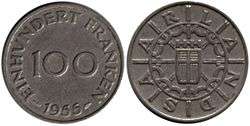Saar franc
Saar franc refers to the French franc (German: Franken) used as the official currency of the Saar during the two times that the Saar territory was economically split off from Germany, i.e. 1920–1935 as the Territory of the Saar Basin; and 1947–1957 as the Saar Protectorate and 1957–1959 as the state of Saarland in West Germany. Although local notes and coins were issued during both periods, legally the Saar franc was never an independent currency.
History
1920–1935

The Treaty of Versailles stated in article 45 that the newly formed territory would be administered by the League of Nations for 15 years, and that during that time France was granted the complete benefit of the Saar coal mines. The new French administration of the coal mines was granted the right to process all financial transactions with French francs. Therefore, from 1921 to 1923 the French franc was used alongside the German mark (ℳ), and from 1923 on, when the Saar Territory was incorporated officially into the French economy, the franc became the only valid currency. Due to the shortage of nonferrous metal, the coal mines administration began to print its own banknotes, the so-called "Grubengeld" ("coal mine money"). After 1930, these notes were replaced by the usual French notes.
After the plebiscite of 1935, when the Saar Territory was unified with the German Reich again, the Reichsmark (ℛℳ) was immediately introduced. The official exchange rate was 1 franc = 0.1645 ℛℳ.[1]
1947–1959
On 16 July 1947, banknotes were issued for Saar denominated in marks, which replaced the German Reichsmark. But in November 1947, the French government reintroduced the French franc as the official currency. Between 20 November 1947 and 15 January 1948, all notes and coins had to be exchanged, the exchange course being 20 Saar marks = 1 franc. It was not before 1954 when the government of the Protectorate issued new coins denominated in 10, 20, 50 and 100 francs.[2] But the coins resembled the coins of the French franc and were officially and legally not a currency of their own, but only local issues of the French franc.
After a referendum about the future status of the region, Saarland was incorporated into the Federal Republic of Germany as a Bundesland on 1 January 1957. The economic integration into Germany was completed with the withdrawal of all Saar-Franken two years later. On 29 June 1959 the federal ordinance "Verordnung zur Einführung der Deutschen Mark im Saarland"[3] stipulated that – with effect from 6 July (§ 1) – all debts, credits, deposits, wages, rents, fees, interest servicing, or amortisation payments, and other obligations, as well as cash reserves and prices denominated in francs were to be converted at the rate of 100 francs = 0.8507 Deutsche Mark (§ 2).[4] The conversion had been brought forward by half a year because of the accelerating depreciation of the French franc. The date was kept secret (called "day X") to avoid currency speculation, and only published two days in advance. The freedom to fix new prices was maintained, but especially temporarily or permanently fixed obligations, not to be altered at any time, were not to be renegotiated but converted at the rate fixed.
Appearance and acceptance

Pictures on coins of Saar Protectorate always depicted things related to the industry and mining in the region. Also the coat of arms of the Saar Protectorate appears on every coin. Coins of 10, 20 and 50 francs depicted a factory and mining tower, with the coat of arms of the Saar Protectorate in front of them. 100-franc coins depicted a gearwheel, again with the coat of arms of Saar Protectorate in front of it.
All four coins were identical to the official French coins in color, size and weight, only the writing and the picture was different. There were no genuine smaller coins, as the usual French coins (1, 2, 5 francs) were used instead. All French coins were accepted in the protectorate, whereas the Saar coins were usually not accepted in France, except in the bigger cities adjacent to the border.
References
- ↑ The Saar money
- ↑ Linzmayer, Owen (2012). "Saar". The Banknote Book. San Francisco, CA: www.BanknoteNews.com.
- ↑ Bundesgesetzblatt (BGBl., federal law gazette) I, p. 402
- ↑ The Federal Republic of Germany fixed that rate and converted older obligations denominated in Saar francs at this rate into Deutsche Mark. Cf. the federal act on compensations "Bundesgesetz zur Einführung des Bundesgesetzes zur Regelung der rückerstattungsrechtlichen Geldverbindlichkeiten des Deutschen Reichs und gleichgestellter Rechtsträger (Bundesrückerstattungsgesetz – BRüG) im Saarland", which – in its Art. II, No. 8 – mentions the official rate.